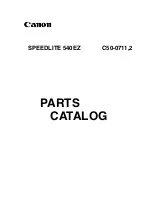
II Operations
4 Simple Surface Reflection Interference Observations Using Epi-fl Attachment
- 26 -
2
Switch off the key switch on the He-Ne laser power unit.
3
Switch off the power switch on the Solid-State laser power unit.
4
Switch off the power switches on the shutter control unit, the main body of the microscope,
and the epi-fl light source.
4
Simple Surface Reflection Interference Observations Using
Epi-fl Attachment
4-1 Objectives
In theory, it is possible to make high-contrast observations of areas in contact with the cover glass
using TIRF illumination. In practice, it is difficult to determine from images using TIRF illumination
alone whether specimens such as cell cultures are actually in contact with the cover glass.
Simple surface reflection interference observations using an Epi-fl attachment easily allow the
observer to determine which parts of the specimen are not in contact with the cover glass, as
indicated by the presence of interference fringes.
If an air gap exists between the cover glass and the specimen (e.g., cell-culture cell membrane),
interference fringes caused by light reflected from the surfaces can be observed with the following
optical settings.
4-2 Attachment Setup Procedure
1) Fluorescent filter block (upper)
Setup:
Fit the G excitation filter and dichroic mirror for UV excitation to the filter block. Do not
put any barrier filters.
Here, remove the TIRF filter block (lower) from the optical path.
Explanation: With these settings, interference fringe components in the light from the specimen
image will be increased by the following effects.
•
Using the G excitation restricts the interference fringe wavelength and allows
observations with more highly visible wavelengths.
•
The characteristics of the UV dichroic mirror ensure high transmissivity with low
reflectivity of visible light, giving an image in which interference fringe intensity is
not reduced.
2) Aperture and field-diaphragm adjustment
Setup:
The aperture should be set to (or as close as possible to) the minimum setting. Adjust
the field-diaphragm opening to the minimum required for viewing.
Explanation:
•
Reducing the aperture enables illumination by near-parallel light rays. If the
aperture is matched to the objective N.A., illumination angles of incidence will be
large corresponding to the N.A.. The resulting wide range of optical path lengths will
reduce interference fringe contrast.
•
Reducing the field-diaphragm aperture blocks unnecessary light, increasing image
contrast.
Содержание TIRF
Страница 1: ...M301 E 03 6 CF 2 TIRF SYSTEM FOR TE2000 INSTRUCTIONS ...
Страница 2: ......










































